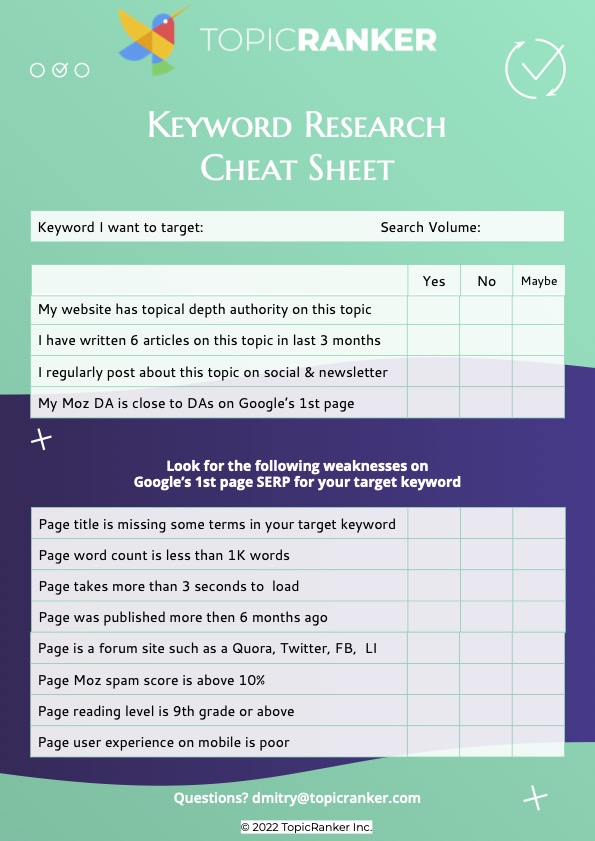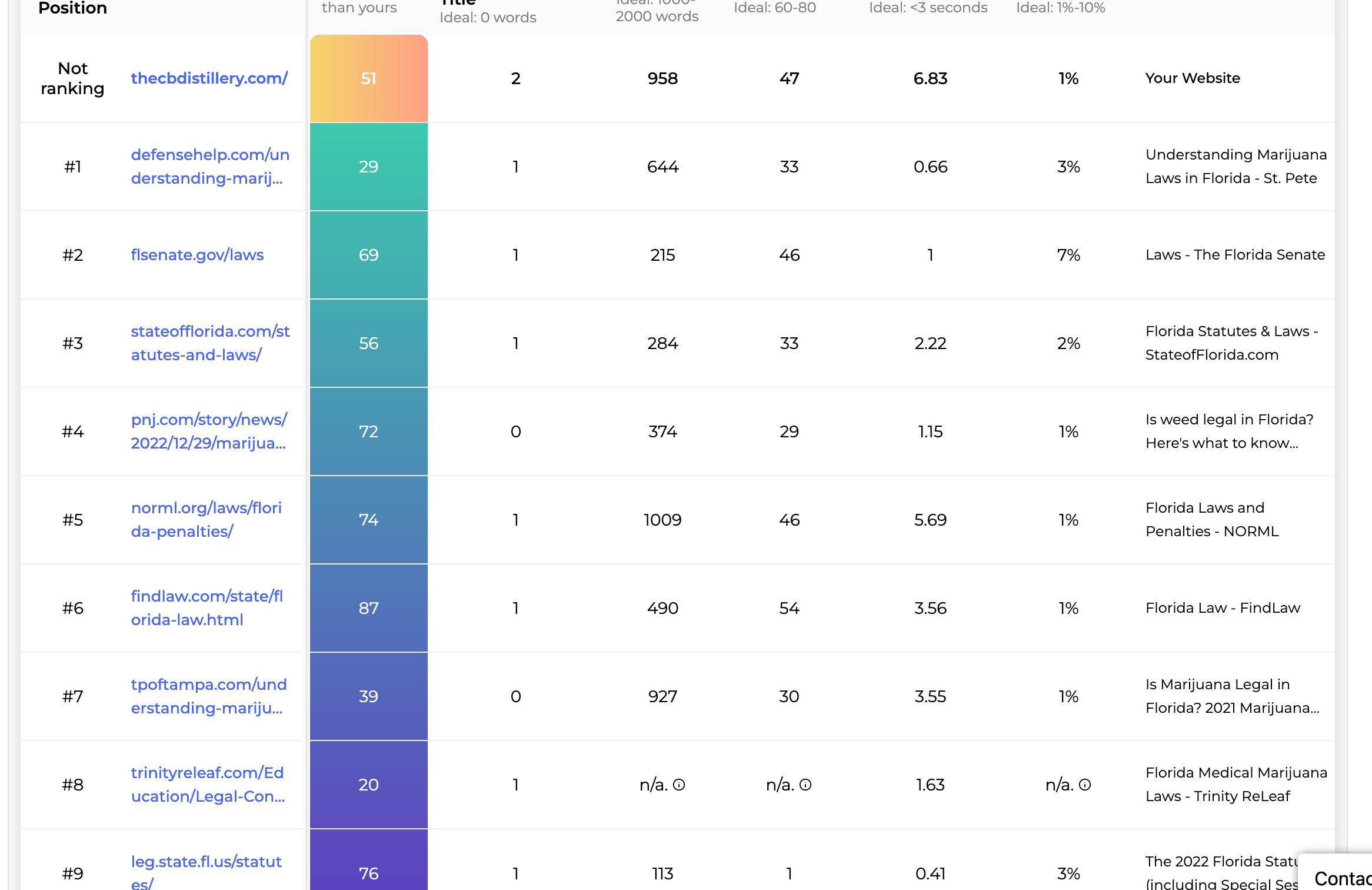Right after I bought the domain TopicRanker.com, I decided that I’m going to make it rank on Google in 2 weeks. I was still building the software platform, so I didn’t have much to put on the website. I created a basic blog and went to work.
Because the blog and the domain was brand new, I was starting out with absolutely no popularity or domain authority. Essentially, Google would have no idea whether my blog was relevant to searchers or not.
My goal was to find one keyword search term where the top Google search results had so many obvious weaknesses and problems that if I created a better piece of content Google would rank me because I addressed all of these issues in search results.
I found the following search term for which the top search results has a TON of problems and weaknesses, it was also relevant to my prosthetic customer, here it is:
Search term: “which keywords are best to target”
Volume: 390/mo
Problems and weaknesses I found on search results :
- top result does not have the exact search term in it’s title
- top 3 results page load is above 3 seconds
- Pages which rank #2 and #4 have only 800 words in the article – too short
- Pages which rank #5 and #6 have poor readability score
These were enough to qualify this keyword for me to go after. Here is what the SERP looked like:

I wrote my article by targeting these weaknesses above:
- Make sure I have the exact search term in my title
- Make sure my page load is 3 seconds or under
- Make sure my content length is 2K+ words
- Make sure my article had a good readability score of 60+
Here is the article titled: Which Keywords Are Best To Target

And…without any backlinks, the article was ranking #1 within a week.

I’ve received 100+ signups from this article alone. Now, I want to teach you to do the same.
Below, I’ll share a step-by-step guide explaining the process I used. Ready? Let’s roll!
What is keyword research?
First thing is first… let’s define what keyword research is.
Keyword research is the process of discovering and analyzing the search terms that your audience is using to find content online. This helps you find out:
- Which keywords are best to target
- What your audience is searching for
With that knowledge, you can target the search terms that are most likely to lead to conversions.
This is why easy-to-rank keywords are so important. These are keywords where the competition is thin. Once you’ve discovered easy-to-rank keywords, you can create strategic content that will help you rank higher on a search engine results page (SERP). This is an effective way to drive organic traffic to your website.
What are easy-to-rank keywords?
Easy-to-rank or low-competition keywords are the keywords that, because of several factors, will be easiest for you to create content that will rank higher on the SERPs. Often, these keywords are low-hanging fruit that has been neglected by your competitors and therefore have weaknesses and problems on search results. When you’re starting out, these are the keywords that will give you the best opportunity to generate organic traffic.
Some of the factors that decide keyword difficulty include:
- Weaknesses & Problems on SERP: We went over this a little bit already above, if there are problems on the google search results it’s an indication that this might be a good search term to go after.
- Relevance: Google prioritizes content that meets the searcher’s needs. The top results will be what Google considers the best resources out there for that query. This means you need to consider search intent (the reason why the searcher is looking up that term). With that in mind, you can create effective, useful content that fulfills their needs.
- Authority: Google gives more weight to authoritative sources. To be deemed authoritative, you should have a wealth of helpful content replete with social signals and backlinks from other highly ranked websites. If the competitors for the keyword are highly reputable sources like Forbes, you’ll have a harder time ranking for that keyword.
- Volume: Measured by monthly search volume (MSV), this is the number of times a keyword is searched for every month. There’s no point ranking for a keyword that no one searches for. But if a keyword has a huge MSV, chances are the competition is extremely high.
Beyond this, you can exploit flaws in the top search results to find easy-to-rank keywords. For example, some of the top results may have low word counts, are not optimized for mobile devices, take a long time to load, or are missing key terms in their headlines.
These weaknesses are opportunities for you to easily rank your articles by creating stronger content. Below, we’ll explain how.
How to find easy-to-rank keywords
In the next section, we’ll break down how you can identify easy-to-rank keywords in six steps. You’ll start by brainstorming a broad list of topics and keywords, then narrow this list down gradually by analyzing the competition for weaknesses.
Step 1: Come up with a list of potential topics
To start this process, think broadly about general topics that you want to or could rank for. These topics should be related to your website and should stem from your core expertise.
Once you have a list of topics, generate an exhaustive list of keywords that fall under those topics. These are the specific terms that are important because your target customers are probably searching for them.
For example, if you run a business texting software platform company such as SalesMessage (one of our customers at TopicRanker), then you would brainstorm a series of topic phrases that people would search for relating to business texts, like:
- Sample SMS text messages to customers
- How to text customers to show up to a call
- How does sms texting work for businesses
Don’t worry too much about the quality and type of topic at this stage. We’ll narrow them down to the most effective terms during the next steps.
Also, aim for a list of both head terms (like” business texting”) and long-tail keywords (much more specific phrases, like “Sample SMS text messages to customers”). You’ll end up targeting more long-tail keywords as these are less competitive and easier to rank for.
There are several free and paid tools that can help brainstorm topics for your content generation strategy.
Here is how I do this with TopicRanker:
Alternatively there are a few tools you can use together with TopicRanker such as:
- KeywordsEverywhere. A freemium browser extension that can show you related keywords, phrases people also search for, trending keywords, and long-tail keywords relating to any Google SERP or web page.
- Ahrefs. Discover keyword ideas by plugging in your seed phrase. For each keyword, Ahrefs will provide a stack of SEO metrics to help you choose which are best to go with.

- Exploding Topics. This tool analyzes searches, conversations, and mentions to find trends and market opportunities. You can use these insights to inform which keywords you should target.
The best part? All of these tools can be paired with TopicRanker to analyze SERPs to find specific ones which have a weakness in them.
For example, check out how this YouTuber uses Ahrefs and TopicRanker together. By plugging in the seed topics into TopicRanker, you can find easy-to-exploit weaknesses in the SERPs.
With a preliminary list in hand, it’s a good idea to set up a basic spreadsheet. As you move through the article, you can add notes and assess each keyword at the end.
Step 2: Look for weaknesses in the SERPs
Another key factor to consider when doing keyword research is the quality of the competition on Google. If you’ve found a keyword that you could rank for, the next step is to analyze the competition for a range of weaknesses that will make it easier for you to rank.
These weaknesses include:
- Domain authority: As mentioned above, if you find that the top 10 spots on Google have a lower Moz DA than yours, there’s a good chance you will outrank them for that keyword. Take a look at the example for OutplayHQ.com with Moz DA 34 below, you can see that the article ranking #2 is Moz DA 35, which is a strong signal that OutplayHQ can outrank them if they create something better.
- Title mismatches. This is when there are words missing from the meta title that are included in the search query. Ideally, there should be none missing. For example, when you search “fixed money supply”, the first result doesn’t have this phrase in the title at all. This has a serious impact on SEO as readers are likely to skim over it.

- Low word counts. The word count of your article should be between 1,000 and 2,000 words to be competitive. A low word count on the ranking articles is a sign that they are thin in content and could be improved on.
- Readability. Content should be written at a 7th to 9th-grade reading level, which corresponds to a Flesch Reading Ease Score of 60 to 80. A reading level of 10th grade or over (or a Flesch score of under 60) is challenging for most online readers. You can capitalize on this weakness with an article that’s well-written and easier to read.
- Load times. According to Google, the load time of a web page should be under 3 seconds. If the top articles for your keyword show load times higher than this, you can outrank them by producing a faster-to-load page.
- Spam scores. You can use SEO tools to determine the spam scores for the pages in the top 10 results. If they have spam scores of over 10%, you have a chance to rank by developing better content that’s less spammy and more informative.
You can also use a dedicated keyword research tool like TopicRanker to determine problems in the Google search results. TopicRanker finds easy-to-rank keywords by analyzing key weaknesses like:
- Missing keyword terms in page titles
- Pages under 1,000 words long
- Load times over three seconds
- Posts that are over six months old
- Results that are from forum sites like Quora, Facebook, or Reddit
- Pages with spam scores over 10% and a reading level at the 9th grade or higher
- Webpages that underperform on mobile
Your goal is to find keywords that have a few of these weaknesses. They don’t have to have every weakness, but the more there are, the easier it’ll be to rank for that phrase.
If you learn better by listening vs. reading, I recently hosted a roundtable discussion at Rhodium Weekend on how to find keywords you can easily rank for on Google. Here is the cheatsheet and recording from it:
And if you learn better from visuals, here is a worksheet to use when thinking about weaknesses:

Step 3: Remove topics that aren’t related to your domain authority
Remember how Google determines ranking based on relevance? It’s time to take that into consideration and narrow down your keywords based on whether they fit your domain authority.
The more you post great content about a general topic (for example, SEO or local SEO topics), the more likely Google is to see your website as an authoritative source in that context.
Ask yourself the following questions:
- Does my website have topical depth authority on this general topic?
- Have I written at least 6 articles on this topic in the last 3 months?
- Do I regularly post about this topic on social media and via my newsletter?
If you answer no to any of these questions, you’ll have a much harder time ranking for them – especially if the top 10 results are highly authoritative. So, remove any keywords for which you answered no to all three questions.
Step 4: Check the monthly search volume (MSV)
The next thing to do is check how popular the search term is. You don’t want to target a keyword that nobody is searching for. However, high-volume keywords are often difficult to rank for as they are broader and usually very competitive.
Instead, target keywords that have 50 to 500 people searching for them per month. At this level, you have a good chance of ranking.
Using the Keywords Everywhere add-on, you can easily get search volume and traffic estimates for the search terms you’re considering.

You can also easily check search volumes using TopicRanker:

Add these volumes to your spreadsheet and flag the terms that have too little or far too much traffic. You’ll probably cut these from your list before moving to the next step, but there’s one last thing to check.
There’s one exception to the rule of not targeting very low-volume keywords. In the Keywords Everywhere plug-in, you’ll see the “Trend” column. This shows you whether the searches for that keywords are increasing, falling, or staying the same. .
If you see any that are projected to rise in popularity, it could be a good idea to target them before they get competitive. That way, you’ll have ranked for the term before they become higher in difficulty.
Step 5: Analyze the competition
With a narrowed-down list of keywords and a good idea of search volume, it’s time to check out the competition. You’ll want to assess both the amount and strength of the competition, as both of these factors can affect how difficult it is to rank for a keyword.
The first thing to check is how your Moz Domain Authority (DA) compares to the DAs in the search results for each keyword. Moz DA is a metric that measures the popularity and authority of a website, based on factors like the number and strength of backlinks.
The Moz DA ranges from 0-100, with a higher score indicating a higher authority (and a higher chance of ranking). You can easily qualify your Moz DA by using TopicRanker. Simply plug in your keyword, and it will show you how your website’s Moz DA compares to the SERPs for that term:

The Keywords Everywhere add-on also shows Moz DA:

When judging whether a keyword will be easy to rank for, compare your Moz DA to that of the websites on Google’s first page. If your result is close to the average Moz DA of the top ten results, you have a decent chance of ranking for that keyword.
Next, take into account the quantity of competition. If the first two results on Google are particularly strong, but the quality drops off significantly after that, then you have a chance of ranking. However, if there are dozens of high-quality articles with strong Moz DAs, that keyword is likely going to be too difficult.
Step 6: Consider user intent and finalize your list of keywords
By now, you should hopefully have found easy-to-rank keywords that:
- Satisfy the conditions about topical depth authority and regular posting.
- Have a monthly search volume between 50 and 500 (or lower if they’re trending upward).
- Have 2-3 (or more) of the weaknesses listed above.
However, to rank for them, you still need to generate useful content that outperforms the competition. This means you need to take into consideration the user intent behind the search queries.
Not only can this guide your approach to content creation, but it can be a final step in assessing weaknesses in the SERPs.
Google’s job is to answer people’s searches with contextually relevant articles, based on clues in their search queries. If the content in the top search results doesn’t match the user intent, you have an opportunity to fill the gap and provide the content that those people are looking for.
To assess user intent, ask yourself the following questions:
- Who’s searching for the keyword? Are the search results targeted at experts rather than beginners? Is there a mismatch where the top content isn’t meeting user needs?
- What are they looking for? Do they want to buy a product or service, find information, or navigate to a specific web page?
- What angle are the top results taking? Is there an opportunity to fill a gap that hasn’t been addressed yet?
Once you’ve answered these questions, you should have a decent idea of the kind of content that’ll stand out and meet the needs of your visitors.
Time to start creating
Targeting low-competition keywords is a great way for less-established websites to get their foot in the door and land a place in the top search results. Every article you rank means more site credibility, more ranking articles, and more conversions.
With a list of easy-to-rank keywords and a vision of the content you need to create, there’s nothing left to do but write. So it’s time to get started!
Read what’s next:

Dmitry is the founder of TopicRanker – a software tool to find problems & weaknesses on Google search results and discover keywords you can easily rank for with your website. Over the last 10 years, Dmitry has helped 300+ brands rank #1 on Google through PR and SEO. Dmitry used PR & SEO to grow a startup from 0 to 40 million views per month, and got acquired by Google in 2014. He translated his know-how into JustReachOut.io, a SaaS tool to get covered in press and build authority backlinks without PR firms; it’s been used by 5000+ content marketers to date and was acquired in 2020.


